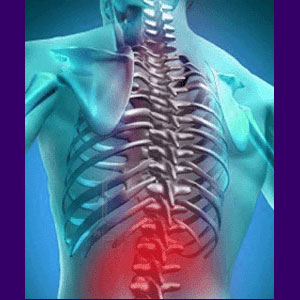
Posterior ramus syndrome is a controversial diagnosis in the lower back pain arena and is also known by the names dorsal ramus syndrome, thoracolumbar junction syndrome (TLJS) and Maigne syndrome. The condition describes a nerve pain disorder based on structural issues at the thoracolumbar juncture or surrounding vertebrae.
Dorsal rami syndrome is theorized to be the source of symptoms in a great number of patients by physicians who embrace this causative theory of pain and utilize a particular evaluation procedure to verify the diagnosis. Many other doctors simply view Maigne Syndrome as yet another structural scapegoat condition blamed for pain, but not the actual source of suffering.
This dialog explores thoracolumbar junction syndrome as an explanation for neurogenic lower back pain.
What is Posterior Ramus Syndrome?
Posterior rami are the rearward directed branches of the nerve roots which exit the spinal column at each vertebral level. Typically, these dorsal branches are smaller than the anterior branches and the ones from the thoracolumbar junction innervate 3 distinct areas which are also used for diagnostic purposes.
Pain may be experienced in any or all of these areas due to dorsal nerve root irritation, most commonly blamed on facet joint degeneration and/or interaction at the affected levels: lower back and buttocks pain, groin pain, or frontal/side thigh pain often misdiagnosed as sacroiliac pain or trochanteric bursitis.
In essence, TLJS is yet another nerve pain theory stating that the neurological roots in the lowest thoracic and upper lumbar regions are being affected by some manner of irritation, usually enacted by the usual degenerative changes seen in the facet joints at this frontier level of the vertebral column.
Diagnosis of Posterior Ramus Syndrome
Diagnostic imaging is not a factor in the diagnosis of TLJS, as opposed to almost all other types of structurally-induced back pain. Instead, diagnosis is made based on a patient interview, symptomatic expression and manual examination of the affected area, as well as possible diagnostic confirmation via anesthetic facet joint injection.
The affected nerve roots are usually T12 or L1, but may include T11 or L2 in some patients. The doctor will examine the patient bent over in a particular position, using direct finger pressure along the spine to find tenderness and sensitivity in or around each facet joint and at the iliac crest.
The doctor will also use skin rolling and vertebral rotation testing to narrow in the location suspected to be to source of pain. Once the facet joints in question have been isolated, an injection will usually be administered and the patient monitored for signs of symptomatic resolution using similar testing.
Posterior Ramus Factsheet
I have spoken to many doctors who feel that the thoracic-lumbar juncture is truly the site of pain in many patients and others who dismiss it. Among those who accept the location as causative in many cases, some subscribe to the TLJS diagnosis, but most do not.
Some physicians actually laugh at the idea of TLJS, and particularly the diagnostic methods used, noting the inaccuracy of diagnostic confirmation via injection. An anesthetic will certainly relieve almost any type of pain in the area, since it is an anesthetic. It does not necessarily identify the source of the pain, particularly since many lower back pain sufferers have widespread and often variable pain patterns. The doctors who simply dismiss this diagnosis often blame the pain on muscular issues or completely non-structural sources, which are just as logical when viewed objectively.
If you are diagnosed with thoracolumbar junction syndrome, be very careful, since the diagnostic conclusion may be flawed, leading you on a wild goose chase for treatment. I highly recommend getting at least 2 other diagnostic opinions, from different kinds of care providers.




